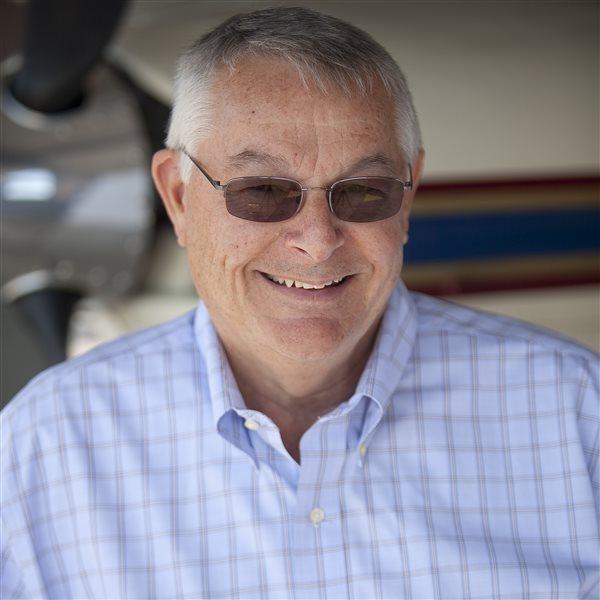His résumé doesn't tell the whole story. It indicates he went here, did that, then went elsewhere. Nowhere is there an indication that Darryl Greenamyer is one of aviation's legendary pilots.
In the language of a résumé, the accomplishments all sound ho-hum: won the Reno National Championship Air Races seven times out of 11 tries (Unlimited class), built a Lockheed F-104 out of spare parts and set a world speed record with it, and was a test pilot for the Lockheed U-2, A-12 (a version of the SR-71), and SR-71 spy planes. He also tested the F-104. Near the end of the résumé is a handwritten addition to his list of aircraft flown: "3 seconds, B-29 (bump)." This is a résumé that could use a few details.
Take the home-brew F-104, for example. He dubbed it the RB-104 Starfighter, with the RB standing for Red Baron. Beginning in the mid-1960s Greenamyer began "accumulating" parts to build it so that he could attempt to capture various speed and altitude records. On October 24, 1977, he set a low-altitude speed record of 988.26 mph that still stands today. He flew at 30 and 80 feet above the ground as the rules require, preventing pilots from diving onto the timed course. "I'd love to see the Air Force or the Navy try and break that record," he said.
The parts came from wrecks, mock-ups, and excess inventories that were sold off by the government. "In most cases, they were new parts," Greenamyer said. The front fuselage came from two different Lockheed mock-ups.
"The tail was from a scrap yard somewhere," Greenamyer recalled. The horizontal stabilizer came from a parts inventory he bought when Lockheed quit building the aircraft. The nose, which had reaction controls for use at higher altitudes, came off a 104 sitting on display at Edwards Air Force Base. The reaction controls would be needed for an altitude record he hoped to set later. The engine had to be both begged and borrowed.
"A friend of mine took me to the Pentagon to ask the Air Force for an engine," Greenamyer said. The Air Force thought it was ridiculous. So he went down the hall to the Navy, which agreed to loan him one. The engine had a different configuration than the airplane, and forgings in the fuselage had to be ground down to fit. It worked, and he set a new speed record.
After setting the record the aircraft had a mishap. During a flight test on February 27, 1978, the gear failed to lock down. You do not belly in an F-104, so Greenamyer ejected and the aircraft was lost. He jokes that he flew it for 12 hours after 12 years of work, but actually he flew it 15 hours.
Greenamyer's earlier career was as a Lockheed test pilot. That job created an opening for his racing career. The SR-71 testing program was beginning just as races were starting up at Reno, Nevada. It took Greenamyer three months to get a security clearance for the A-12 , so while he was waiting he bought a Grumman F8F Bearcat and made it fast enough (in excess of 480 mph) to win at Reno.
Not even the SR-71 had enough speed for Greenamyer. "I'd get up in the morning, drive to Palmdale [California, home of the Lockheed Skunk Works], have breakfast, get in the SR-71, fly to Florida, hit a tanker, come back, and have lunch. After doing this for a while, I'd be coming across Texas and I would think, 'Something's wrong. It's not going fast enough.' Well, it's going fast enough [in excess of 2,000 mph]. You just get used to it. You adjust. You want more. I've never flown anything that had enough horsepower."
Now, about those three seconds in a B-29. That was his attempt to rescue the Kee Bird from northwest Greenland, where it had crash-landed during a reconnaissance mission in 1947. That adventure sprang from yet another of his aviation careers, buying and selling aircraft and retrieving unusual aircraft for various museums. (His Bearcat now belongs to the Smithsonian National Air and Space Museum.) Greenamyer and a small crew succeeded in getting the aircraft on its gear, installing new engines, and in 1995, taxiing it to test the engines. That's when a bump in the ice lofted him into the air for three seconds — the last time the Kee Bird was in the air. A fuel line had apparently leaked onto a generator and the aircraft burned. All aboard escaped.
At 66 Greenamyer is still at it — racing a 347-mph Lancair Legacy and winning. And danger? Yes, there have been crashes, fires. But there isn't room here to include all that — just enough space to list some of the achievements that make him a legend.



